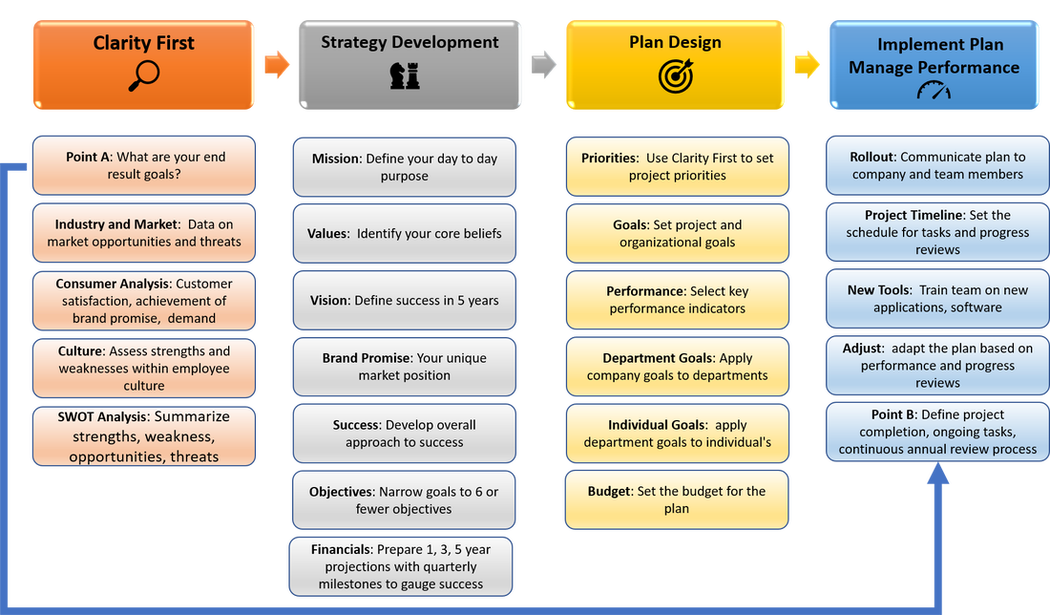“A vision and strategy aren’t enough.
The long-term key to success is execution.
Each day. Every day.”
-Richard M. Kovacevich
The long-term key to success is execution.
Each day. Every day.”
-Richard M. Kovacevich
Our Process Takes You
from Point A to Point B
Intake and Orientation Phase
Phase Duration
2-4 weeks
2-4 weeks
- 1 -2 hr meeting with Owner/CEO and Project Manager to discuss broad goals, required information, team members and the direction for the continued strategic and project planning
- 1-2 hr meeting with project team members to review data provided and identify additional requirements
- Daily Follow-Up For Collection Of Data
Step 1: Determine Organizational Readiness
Set up Your Process for Success – Questions to Ask:
Step 2: Develop Your Project Team & Schedule
Step 3: Intake Current Data
Collect the following information on your organization:
Step 4: Analyze Collected Data
Review the data collected in the Project Manager and Team Leaders:
Set up Your Process for Success – Questions to Ask:
- Is my company ready to go forward?
- Are communications structures in place to align employees behavior with your goals?
- Is the timing right to launch the project? If not, when?
Step 2: Develop Your Project Team & Schedule
- Identify Project Managers, Team Members and the key individuals and decision makers
- Define the communication hierarchy
- The team(s) she be no more than 8-10 persons
Step 3: Intake Current Data
Collect the following information on your organization:
- The current business plan
- Current mission statement, vision statement, values statement
- Financial records for the last few years
- Current marketing plan
- Other project specific information
Step 4: Analyze Collected Data
Review the data collected in the Project Manager and Team Leaders:
- Identify strengths
- Identify weaknesses
- Quantify trends
- Are there existing Project Management plans and project management tools or have you been allowing each project to develop its own process or going along with the market?
- Project team members are informed of their roles and responsibilities
- Required information is collected
- Overall project due dates established
- Existing planning information and additional data collected
- Identify macro and micro trends in your industry, market opportunities and threats, customer demographics an geographic distributions, employee feedback and workplace issues
Ideation and Analysis Phase
Phase Duration
1-2 months
1-2 months
- Daily interaction with Team Leaders
- Weekly meetings with team members of 1-2 hrs
- Monthly meeting with Owners/CEO
Step 1: Develop Your Mission Statement
The mission statement describes an organization’s purpose or reason for existing day to day - it's the promise you make to your customers and defines your brand.
What is our purpose? Why do we exist? What do we do?
Questions to Ask:
Outcome: A short, concise, concrete statement that clearly defines the scope of the organization.
Step 2: Discover Your Values
What do you stand for, believe in and what are the behaviors you expect to see by your employees?
Questions to Ask:
Outcome: Short list of 5-7 core values.
Step 3: Your Vision Statement
A Vision Statement defines focus on the future envisioned for the company and is the reason your employees work every day to achieve your Mission.
Where are we going and why?
Questions to Ask:
Outcome: A vision of the future company.
Step 4: Competitive Advantages
Identify your unique characteristic(s) that allow you to meet customer’s need(s) better than their competition.
What are we best at? Why are we unique?
Questions to Ask:
Outcome: A list of attributes which define your brand promise and your unique value proposition in your market.
Step 5: Design Your Company-Wide Strategies
Establish methods you intend to use to reach your vision. No matter what the level, a strategy answers the question “how.”
How will we succeed? How will we deliver our brand promise? How do fix it?
Questions to Ask:
Outcome: Establish the general systems you intend to use to reach your vision.
The mission statement describes an organization’s purpose or reason for existing day to day - it's the promise you make to your customers and defines your brand.
What is our purpose? Why do we exist? What do we do?
Questions to Ask:
- What does your organization intend to accomplish?
- Why do people work here?
- Why is it special to work here?
- What would happen if we were not here?
Outcome: A short, concise, concrete statement that clearly defines the scope of the organization.
Step 2: Discover Your Values
What do you stand for, believe in and what are the behaviors you expect to see by your employees?
Questions to Ask:
- What are the key non-negotiable behaviors that are critical to the success of the company?
- What are the guiding principles that are core to how we work at this company?
- What are your expectations for employee character and behavior?
Outcome: Short list of 5-7 core values.
Step 3: Your Vision Statement
A Vision Statement defines focus on the future envisioned for the company and is the reason your employees work every day to achieve your Mission.
Where are we going and why?
Questions to Ask:
- What will your organization look like 5–10 years from now?
- How do you define success?
- What are aspirational goals?
Outcome: A vision of the future company.
Step 4: Competitive Advantages
Identify your unique characteristic(s) that allow you to meet customer’s need(s) better than their competition.
What are we best at? Why are we unique?
Questions to Ask:
- What are your unique strengths?
- What are you best at in your market?
- Do your customers value your brand? Ask them.
- How is your reputation in the marketplace?
- How does your brand promise compare to the competition?
Outcome: A list of attributes which define your brand promise and your unique value proposition in your market.
Step 5: Design Your Company-Wide Strategies
Establish methods you intend to use to reach your vision. No matter what the level, a strategy answers the question “how.”
How will we succeed? How will we deliver our brand promise? How do fix it?
Questions to Ask:
- Is your market or industry target broad or narrow?
- Broad: market scope: a relatively wide market emphasis.
- Narrow: limited to only one or few segments in the market
- Does your competitive position focus on lowest total cost or product/service differentiation or both?
Outcome: Establish the general systems you intend to use to reach your vision.
Development and Design of Strategic and Operational Plans Phase
Phase Duration
1-2 months
1-2 months
- Daily to weekly interaction with Team Leaders and team members
- Weekly meetings with team members of 1-2 hrs
- Bi-Monthly meeting with Owners/CEO
|
Step 1: Set Priorities
Evaluate the set of goals and identify the ones that provide the greatest benefit, and that best achieve your mission and vision. Questions to ask:
What is the first thing I need done? Step 2: Set Long-Term Strategic Goals Your Long-Term Strategic Goals are broad, continuous statements that holistically address all areas of your organization. These often captured in a business plan and your Culture Handbook. What is our business plan to achieve our vision? What is our focus? How does our culture support the achievement of our vision? Questions to ask:
Outcome: Build key long-term goals – no more than 6. Step 3: Communicate Company Wide Goals and Expectations In Your Culture Handbook Or Specific Project Management Plan Once you have formulated your strategic objectives or project objectives, we translate them into goals and measures that can be clearly communicated to your employees. We set goals that convert into specific performance targets. Each goal clearly states what, when, how and who is accountable and specifically measurable. Project management plans set the tasks and timelines for specific short term goals. Company wide goals are the long-term objectives that are specific, measurable, attainable, responsible and time bound. These are outcome statements expressed as a result expected of your employees and the company overall. What do we have to do today, tomorrow, next week and next month to reach our long-term objectives? Outcome: Clear outcomes communicated for each project. Step 4: Select KPIs Key Performance Indicators (KPI) are the key benchmarks used to measure the impact of strategic plan or project outcome. We define your KPIs with you, communicate them to your company and hold Team Leaders accountable for performance. When selecting your Key Performance Indicators, begin by asking “What are the key performance benchmark we need to track in order to monitor if we are achieving our goals?” How do you measure your success? Outcome: 5-7 benchmarks to maintain accountability for your performance. Step 5: From Strategic Planning To Operational Planning A strategic plan or project plan is meaningless without an operational plan with individual tasks that result in a desired outcome. The operational plans incorporate the full spectrum of human resources necessary to accomplish the tasks. We develop the full set of strategic and operational plans so that your company goals are aligned with project management plans. Sometimes we align existing operational and business plans with newly developed strategic goals. The greatest mistake is to have multiple sets of goals and actions for directors and staff to manage. That said, the only way strategy gets executed is to align resources and actions from the bottom to the top to drive your vision. Questions to Ask
Outcome: Everyone knows what they need to do, when, why and how their performance will be measured over the project life and strategically for the next 1 - 2 years. Step 6: Project Management Plan
A project management plan is the operational plan to execute the strategic plan and will provide the specific tasks that must be accomplished to complete the project.
|
Roll Out Phase
Phase Duration
1-10 months
1-10 months
- Interaction as need with Team Leaders and team members
- Bi-Weekly meetings with team members of 1-2 hrs
- Monthly Meetings with Owners/CEO
Step 1: Implementation
Implementation is the process that turns your strategies and plans into actionable tasks organized in sequence to achieve your project objectives and strategic goals.
How do you use the Project Management Plan?
Questions to Ask:
Outcome: Integrate your Strategic Plan or Project Plan into the “rhythm of your business.”
Once your resources are in place, you can set your implementation schedule. Use the following steps as your base implementation plan:
Now you’re ready to start your plan roll-out.
Step 2: Tracking Goals & Actions
Meetings don’t need to take a lot of time – 30 to 60 minutes should suffice if team members come prepared to report on their progress for the tasks they are responsible for. By using project benchmarks, it's easy to see where the project is and make course corrections if necessary. Key Performance Indicators (KPIs) can also be adjusted to reflect the dynamics of a project's evolution.
Outcome:
Step 3: Review & Adapt
Guidelines for Your Strategy Review
Review prior accomplishments and identify adjusted priorities in addition to the regular progress performance metrics. A static plan is planning to fail as no business is static. Team members are expected to raises issues that require the plan to adapt to emergent conditions and develop these concepts to maturity as plan changes.
Outcome: Team members continuously contribute progress data to keep the project plan aligned with current and emergent issues.
Step 4: Review
The reality is that a majority of organizations do not review and update their strategic plans. Don’t be part of the majority! Research shows that 70% of organizations that have a formal execution process out-perform their peers. (Kaplan & Norton).
We provide a schedule for the next 12 months that spells out when the quarterly strategy reviews are, who is involved, what participants need to bring to the meetings and how you will adapt the plan based on the outcomes of the reviews.
You remain in this review phase of the strategic management process until you embark on the next formal planning stage where you start back at the beginning because of a significant change in your business.
Review Meetings Plan
Purpose
Attendees:
Preparation Required:
If an item is off track and requiring attention, the report should include a short comment from the item’s owner explaining the performance gap and what actions are being taken or proposed to address them
Everyone in attendance should read the report and be ready to discuss
Implementation is the process that turns your strategies and plans into actionable tasks organized in sequence to achieve your project objectives and strategic goals.
How do you use the Project Management Plan?
Questions to Ask:
- Communication Schedule: How and when will you roll-out your plan to your employees? How often will you send out updates?
- Project Manager: Who is your Project Manager?
- Timeline: What are the dates or cycle for your progress reviews?
- System & Reports: What are you expecting each team member to come prepared with to those progress review meetings?
Outcome: Integrate your Strategic Plan or Project Plan into the “rhythm of your business.”
Once your resources are in place, you can set your implementation schedule. Use the following steps as your base implementation plan:
- Establish your performance management, assessment and reward system.
- Set up regular project review meetings weekly and strategy meetings monthly and quarterly with established reporting procedures.
- Set up annual review dates.
Now you’re ready to start your plan roll-out.
Step 2: Tracking Goals & Actions
Meetings don’t need to take a lot of time – 30 to 60 minutes should suffice if team members come prepared to report on their progress for the tasks they are responsible for. By using project benchmarks, it's easy to see where the project is and make course corrections if necessary. Key Performance Indicators (KPIs) can also be adjusted to reflect the dynamics of a project's evolution.
Outcome:
- Ownership: Employees have a stake and responsibility in the plan because they feel are part of it and this leads to more productive culture.
- Culture: Successful plans tie tracking and updating goals into organizational culture.
- Implementation: You have to inspect if you are going to expect.
- Accountability: Equality in accountability and high visibility help drive cultural change. Every task, objective, data source and initiative must have an owner who is held accountable for their performance.
- Empowerment: Changing tasks from "In Progress" to "Completed" feels good!
Step 3: Review & Adapt
Guidelines for Your Strategy Review
Review prior accomplishments and identify adjusted priorities in addition to the regular progress performance metrics. A static plan is planning to fail as no business is static. Team members are expected to raises issues that require the plan to adapt to emergent conditions and develop these concepts to maturity as plan changes.
Outcome: Team members continuously contribute progress data to keep the project plan aligned with current and emergent issues.
Step 4: Review
The reality is that a majority of organizations do not review and update their strategic plans. Don’t be part of the majority! Research shows that 70% of organizations that have a formal execution process out-perform their peers. (Kaplan & Norton).
We provide a schedule for the next 12 months that spells out when the quarterly strategy reviews are, who is involved, what participants need to bring to the meetings and how you will adapt the plan based on the outcomes of the reviews.
You remain in this review phase of the strategic management process until you embark on the next formal planning stage where you start back at the beginning because of a significant change in your business.
Review Meetings Plan
Purpose
- Hold leaders accountable for strategic initiatives
- Deeply investigate the strategic status of one initiative
- Focus on whether strategy implementation is on track, where problems are occurring in the implementation, why they’re happening, what actions will correct them, and who will have responsibility for achieving the targets
- Except in unusual circumstances, do not use the meeting to alter or adapt the strategy
Attendees:
- Owners
- Senior Management Team
- Project managers
- Functional and Planning Specialists
- Business Unit Heads
- Strategy Manager
Preparation Required:
- Project Reports: Preparare by Project Managers
- Strategy Reports: Prepared by Strategy Manager and broken up by strategic initiatives
- Objectives & Targets: Color coded by status (on schedule, behind but not needing attention, off track and requiring attention)
If an item is off track and requiring attention, the report should include a short comment from the item’s owner explaining the performance gap and what actions are being taken or proposed to address them
Everyone in attendance should read the report and be ready to discuss
You've got this!
Now let's build the plan and
get Clarity from Point A to Point B!
Now let's build the plan and
get Clarity from Point A to Point B!






